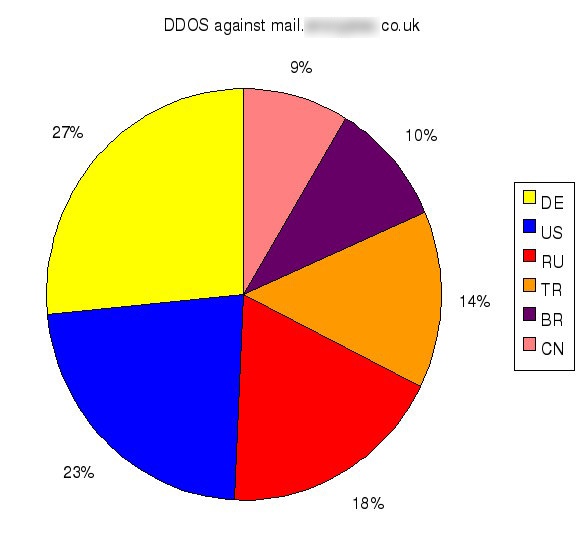Once upon a time there was no internet crime. Then humans came along…
Recently, we came under attack from the Storm / Nuwar Botnet. The post I made about it on the third of October: We had mis-identified it as a referral spam attempt. Close, but no cigar.
Now, I’ve always tried to keep my name & employer from becoming too widely spread on the interweb, although there is a couple of really, really easy ways you can find it, just from this website. (One of them being, ask me 😉 )
It appears, that as a result of the two posts I’ve made about the Storm Worm, someone decided to DDOS not this blog, but my employer’s un-related servers, attacking one of our customers’ managed servers, and then our webmail server. (This blog is hosted from servers in the same rack as those servers.)
At its peak, the attack was drawing 8Mbps of data transfer. (About 1MB per second.)

Graph is read from right to left. <<<<<<< Time Flows that way. <<<<<<<
You can see at 0930, when I got in work and started combating the attack. We only really stopped it the morning this graph just ends on…
Only problem, was that they were flooding our server with requests, literally using every available incoming connection on the server all the time.
For non-techies, a web site is hosted by a computer somewhere on the interweb, that never gets turned off, connected to a really thick pipe to the internet. Its configured to accept a certain number of new people visiting its website(s) at once.
We’ve now completely mitigated this attack (to the point, where at most now its drawing 50kbps 1). Technically, we can mitigate (and sustain) a much more serious attack. This was basically a “Get Lost, and STOP POSTING ABOUT US” poke.
An expensive poke. A sustained 8Mbps transfer rate is expensive in bandwidth!
So far (*wanders off to check*) we’ve identified 23,265 ip addresses which have tried to attack us. That’s a lot of infected computers, but it could have been worse.
It appears the attack has been petering out, we are identifying one new bad ip (infected computer) once every 30-60 seconds. At its peak, we were picking up at least one new ip every second.
If we have another look at that graph of the attack:
The attack started at 1AM GMT, and ramped up to full power in about 20 minutes. That means that it takes the Nuwar / Storm botnet about 20 minutes for a command to filter down into its bots.
At the beginning of the attack, the pattern we were seeing was a bad request from one ip, then 3 different bad requests, then back to the first IP. Sometime during the attack, I think about 1400 or 1500 (2 – 3pm) they switched to hitting us repeatedly from one ip address, showing that someone was probably monitoring at least a small part of this attack, and had noticed that we’d started to block the attacks.
Now, this happened quite a while ago.

So why haven’t I posted about it yet? Why has it taken me 2 weeks to blog about this?
Because, its only now that we feel that we are able to safely weather another attack, should the Zhelatin Gang decide to start poking us again. If they didn’t like me posting what I have, they’re not going to like me posting this.
A message to them: I do not like bullies. Go pick on someone your own size for a change.
Thanks to stopddos.org, for analysing the logs and identifying Storm as our attackers.
UPDATE 20/10/07: A little while ago I sent a part of our logs for geographical analysis to one of the nice guys at castlecops.com.
Here is the graph that resulted from that. This is the top 5 attackers from country, in a pie chart. As you can see, Germany (Country Code DE) was the biggest, closely followed by the US. If you want to see other attack graphs, go here: http://www.spamtrackers.eu/wiki/index.php?title=Botnet_hosting (ours is listed there as BB, moved around to match up with the others, and slightly tweaked.)

- 5KB per second ↩